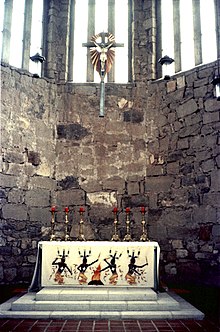Albert Braun
Father Albert Braun OFM (September 5, 1889 – March 6, 1983) was a Roman Catholic priest and teacher in the Southwest and the Pacific United States.
Braun served as an US Army chaplain in both World War I and World War II. During World War II he was held prisoner of war and survived the Bataan Death March. He was a recipient of the Purple Heart, two Silver Stars and the Legion of Merit.[1]

Early life
he was born John William Braun to German immigrants in Los Angeles, California.[2] Braun was ordained in 1915 and his first assignment was to the Mescalero Apache Reservation in 1916.[3]
World War I

In June 1918, he was permitted by his superiors to enlist as a US Army chaplain at Fort Bliss, El Paso, Texas. He soon saw action with the 6th Infantry Division in one of the bloodiest World War I battles fought by American troops, the Meuse-Argonne Offensive. Instead of staying in safety at the rear, the unarmed chaplain went "over the top" with the first assault and suffered shrapnel wounds to his jaw. Despite his injuries he remained on the battlefield to minister to the wounded and to give last rites to the dying. For these actions, Braun received the Purple Heart.
Following the war, Braun helped to construct St. Joseph Apache Mission Church, finished in 1939.
World War II
Braun received orders to report for duty on November 1, 1940, at Fort Sam Houston. He insisted on an overseas posting and was assigned as a chaplain with the 92nd Coast Artillery Regiment in the Philippines. In April 1941, he left for his assignment on the island of Corregidor in Manila Bay. Braun was on hand as Douglas MacArthur was evacuated from Corregidor. He gave the invocation for the inauguration of Philippine President Manuel Quezon on January 1, 1942, in Corregidor, and was present when General Jonathan M. Wainwright surrendered to the Japanese on May 7, 1942. It was Braun who, despite the threat of personal harm, gained permission from the Japanese officers to bury and cremate the dead and who supervised the work of removing the badly decayed bodies from the caves of Corregidor for proper disposal.
He suffered beatings, hunger, disease and the accompanying humiliations as a POW. He insisted on saying mass for the prisoners despite prohibitions against such service and eventually won concession for such activity.
Braun was liberated, after 40 months as a POW, at Camp Omori in Tokyo Bay on August 29, 1945. The emaciated priest who stood over six feet tall, had wasted from 195 pounds to 115 pounds and had contracted diphtheria, dysentery, pelagra and several bouts of malaria.
Post-war life

Due to injuries sustained as a POW, he could no longer serve as a missionary to the Mescalero Apaches. To aid in his recovery, he was sent by the Army to the Marshall Islands where he participated in Operation Sandstone. He then spent two years stationed in Hawaii.
Braun moved to Phoenix, Arizona, in 1949. In 1953, he helped to found Sacred Heart Church in the Golden Gate Barrio neighborhood.
In 1965, he received the Arizona Medal of Honor and in 1979 the Arizona Veterans Hall of Fame award.
He worked as a teacher at St. Mary's High School.
Braun died on March 6, 1983, in Phoenix. At his request, he was interred at the St. Joseph Mescalero Apache Mission in New Mexico.[4]
Legacy
A memorial to Father Braun is located at Wesley Bolin Memorial Plaza in Phoenix, Arizona. He is often referred to as "The Hero Priest of Corregidor" by those that served with him.
Bibliography
- Dorothy Emerson, Among the Mescalero Apache: The story of Father Albert Braun, 1973
References
- ^ "Father Albert Braun O.F.M. Marker". Hmdb.org. Retrieved July 21, 2013.
- ^ "New Mexico Office of the State Historian : Mescalero Apache". Newmexicohistory.org. Retrieved 2013-07-21.
- ^ "St. Joseph Restoration Project". Stjosephmission.org. March 6, 1983. Retrieved July 21, 2013.
- ^ http://philippine-defenders.lib.wv.us/pdf/bios/braun_father_albert_bio.pdf
External links
- Bureau of Catholic Indian Missions Digital Image Collection at Marquette University; keyword: albert braun.
- The Indian Sentinel, 1902 - 1962 at Marquette University; keyword: albert braun.
- 1889 births
- 1983 deaths
- American military chaplains
- American people of German descent
- American prisoners of war in World War II
- American Roman Catholic priests
- American schoolteachers
- Bataan Death March prisoners
- American Friars Minor
- People from Los Angeles
- Recipients of the Legion of Merit
- Recipients of the Silver Star
- United States Army chaplains
- World War I chaplains
- World War II chaplains
- World War II prisoners of war held by Japan
